Disclaimer: This section is a TL;DR of the main article and it’s for you if you’re not interested in reading the whole article. On the other hand, if you want to read the full blog, just scroll down and you’ll see the introduction.
- You can only persuade your website visitors to choose your product or service when you address their motivations, needs, and fears.
- Visitors are not concerned or aware of your website sales funnel. They come with their own buying funnel which may or may not match your sales process.
- Consumers go through five stages before making a buying decision. The attention stage, the interest stage, the desire stage, the action stage, and the post-action stage.
- In some instances, buyers follow these stages sequentially. Other times, buyers skip some stages.
Breaking down the buying journey stages Online
- Before you design your website or landing pages for each of the buying stages, you must decipher the actual stages of visitors who land on your site.
- A good starting point is to analyze keywords that drive traffic to your website. Both single keywords and generic search terms come loaded with information. They can indicate whether a visitor is in an early or late buying stage, or not in a purchase process altogether.
- During conversion optimization projects, we use software to mine analytics data for new keywords and understand visitors’ motivations when landing on the site.
Using keywords to understand visitors’ intent
- Create a list of keywords that drive a significant amount of traffic to your website.
- Focus on the top 100 keywords for your website.
- Segment your keyword lists by visitor’s intent, bounce rates, and time spent on the site.
- Be realistic: Do not aim at 100% accuracy. Deciphering visitors’ intent is a qualitative area of research.
The Five Tests for Optimizing Your Website for Every Stage of the Online Buying Cycle
- The attention test: In 2014, visitors were deciding whether they trusted a website in less than half a second.
There are 5 questions you should answer.
- Does your page communicate trust to visitors?
- Are you able to intrigue the visitors and arouse their interest in the first five seconds?
- Do you use attractive images to intrigue visitors?
- Do you carefully craft titles and headlines to capture the attention of visitors?
- Do you grab visitors’ attention through unexpected events
- The interest test:
You need to answer 7 questions for each of your web pages.
- What is the most important information your visitor expects to see on a page?
- To answer this, you need to know what brought your visitors to the website. Go back to the keywords section in this article, figure out your top keywords, and test your page to see if it addresses visitors’ searches.
- Is the information presented on the page relevant to the visitor?
- Is your page visitor friendly?
- Is it easy for your visitor to find the information they need in a quick way?
- Do you present information in a clear way?
- Do you give your visitor a reason to stay on the website?
- The desire test:
- Your visitors are now interested; next, you must convince them that they desire your product or service because it will satisfy their needs or solve one of their problems.
You need to answer 5 questions in the desire test;
- Are you able to convince visitors to stay on your website?
- Are you able to persuade visitors to convert?
- Do you use special offers to increase visitors’ desire?
- Do you communicate unique product benefits, or company benefits, effectively?
- Are you able to use urgency and incentives to increase visitors’ desire?
- The action stage test:
- Every page on your website has a primary action you want visitors to take.
Answer these 5 questions for each of your web pages:
- Do you have the most important action (primary action) defined for the page?
- Do you highlight the primary action on the page using copy and design? (check out our complete guide to effective CTA buttons)
- Is it obvious, logical, and desirable for every user to take the primary action?
- Are your primary actions laid out in a persuasive and clear process from one page to the next?
- The satisfaction test:
- The kind of relationship you have with your customers will depend on the type of product you sell. Some products are a one-in-a-life-time purchase; others have the customer coming to your website on a regular basis.
Answer these 5 questions for each of your web pages;
- Do you provide an easy and clear way for customer service on your website?
- Do you track customer satisfaction with your website?
- Do you track customer satisfaction with your products?
- Do you deploy a customer exit survey on your website?
- Do you keep in touch with your customers via email, social media, and other forms?
Here’s A Longer And More Detailed Version Of The Article.
You can only persuade your website visitors to choose your product or service when you address their motivations, needs, and fears.
Visitors are not concerned or aware of your website sales funnel. They come with their own buying funnel which may or may not match your sales process. Successful marketers identify the buying stage of the potential customer and match each stage with the correct sales methodology and techniques to meet the needs of the customer.
Some prospects enter the sales funnel already prepared to buy. Others, the majority, arrive at your site to either browse, look for information, compare products, or even just kill time.
The five stages consumers go through before making a buying decision are:
- Attention stage: Need recognition
- Interest stage: Information search
- Desire stage: Evaluation of alternatives
- Action stage
- Post action stage
These five distinct stages roll out in sequence for some buying decisions; others skip some stages. If you were to get hungry in the middle of the night (the need recognition), you might skip over the information search and evaluation phases and get right to the purchase stage. The length of time it takes a consumer to go through these phases varies based on a mix of internal and external factors.
The buying stage determines the visitor’s interaction with your website. Each stage requires a particular set of information and an appropriate style of presentation to persuade more potential customers to convert.
Visitors at the need recognition or information search stages are in the early phase of the funnel. They have not invested the time to determine the best solution for their need. The evaluation stage indicates that visitors are in the middle of the funnel. They are closer to making a buying decision. Finally, visitors in the purchase stage are in a late step of the funnel. These visitors have shown a level of commitment and are more likely to convert if you present them with the right information.
In this chapter, you will learn the guidelines to decipher your visitor’s buying stage and to detect your visitor’s intent through the use of keywords. You will also find five tests to help improve your website regarding your customers’ buying phases: the attention test, the interest test, the desire test, the action test, and the satisfy test.
Deciphering the Buying Journey Stages Online
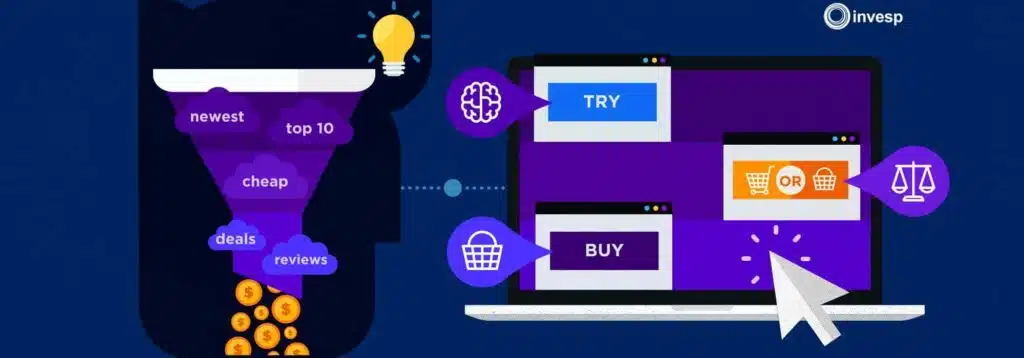
Before you design your website or landing pages for each of the buying stages, you must decipher the actual stages of visitors who land on your site.
A good starting point is to analyze keywords that drive traffic to your website and decode visitor’s intent based on these words. You can then use visitor’s intent as a signal or an indicator of the potential customer’s location in the buying funnel.
Both single keywords and generic search terms come loaded with information. They can indicate whether a visitor is in an early or late buying stage, or not in a purchase process altogether. Other searches might be easier to decipher. The following table shows possible visitors’ intent when they land on a website after searching for the term “laptop.”
| Keyword | Perceived intent | Type of intent | Actionable |
| Laptop | Product evaluation | E-commerce | Yes |
| Laptop technology | Knowledge | Maybe | |
| Laptop history | Knowledge | No | |
| Laptop reviews | E-commerce | Yes |
A visitor could be looking for product evaluation or reviews, or could be ready to buy. In both cases, the visitor is in a buying process, mid or late stage.
A search for the history of laptops, or the latest technology news, indicate the person is not in any buying process.
If a visitor gets to the site by searching for less than generic terms such as “laptop reviews” or “laptop history,” you do not have to do much guesswork. The visitor is letting you know what he/she is looking for. A search for “laptop reviews” indicates the evaluation of alternatives stage.
Another example is a search for “cheap laptops”, which might also signal a ”desire,” although this person is obviously price-sensitive. Finally, a visitor who lands on your website after searching for a particular model, “Dell XPS 13,” is possibly at the purchase stage of the buying funnel.
During conversion optimization projects, we use software to mine analytics data for new keywords and understand visitors’ motivations when landing on the site. A website typically has thousands, if not hundreds of thousands, of keywords that drive traffic to it,which can make the task of analyzing keywords quite challenging.
Using keyword research tools can help save you a lot of time. Marketing experts have recommended tools like SEMrush, Google Keyword Planner and Buzzsumo.
Using Keywords to Decipher Visitors’ Intent
To decipher visitors’ intent by using keywords, use the following guidelines:
- Create a list of keywords that drive a significant amount of traffic to your website. The determination of high-volume keywords depends on your site. For some, a high-volume keyword brings 500 visitors per month;for others, 50,000 visitors per month.
- Focus on the top 100 keywords for your website. For many websites, 80% of their traffic comes from 20% of their keywords. This second list of keywords is another goldmine in determining visitor’s intent.
- Segment your keyword lists by visitor’s intent, bounce rates, and time spent on the site.
- Be realistic: Do not aim at 100% accuracy. Deciphering visitor’s intent is a qualitative area of research. Your goal is to look for general trends to understand what brings visitors to your website.
Search engines spend more time analyzing visitor’s intent based on keywords than any other online entity. The quality of search results,and, therefore,the quality of the search engine itself, depends on providing relevant data to the term a person searched for. Based on linguistics, search engines use complex algorithms to decode visitor’s intent. They also have the advantage of monitoring the pages on which people are clicking when they search for a particular term. If users regularly click on the same result, the engine creates an association between this type of result and the search term.
In the following sections, we will cover how you can improve your website to deal with visitors at each of the buying stages. As you go through each section, you should keep in mind that a wealth of information creates a poverty of interest. Your goal is to provide the right amount of information for each stage and nothing more.
The Five Tests for Optimizing Your Website for Every Stage of the Online Buying Cycle
1. Attention
Are you able to capture the attention of your website visitors in the first five to ten seconds? In 2006, Invesp’s research indicated that online visitors decided whether they trusted a website in three seconds. In 2014, visitors were deciding whether they trusted a website in less than half a second. Which is found to be a normal trend in accordance to human adaptation to growth in technology.
The Attention Test
Answer these questions for each of your webpages:
- Does your page communicate trust to visitors?
- Are you able to intrigue the visitors and arouse their interest in the first five seconds?
- Do you use attractive images to intrigue visitors?
- Do you carefully craft titles and headlines to capture the attention of visitors?
- Do you grab visitor attention through unexpected events?
Let’s take this homepage as an example. This is an ecommerce website (B2C) that provides the service of online gifting. Take a minute to answer the questions above about this homepage before moving forward.
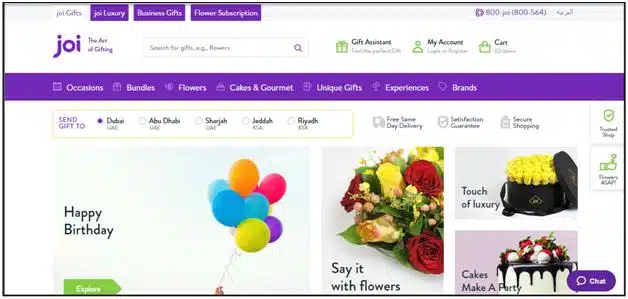
Have you answered the 5 questions?
As you can see, I’ve only shown the area above the fold. Because it is the most crucial area for capturing attention.
Ok, so let’s do it together:
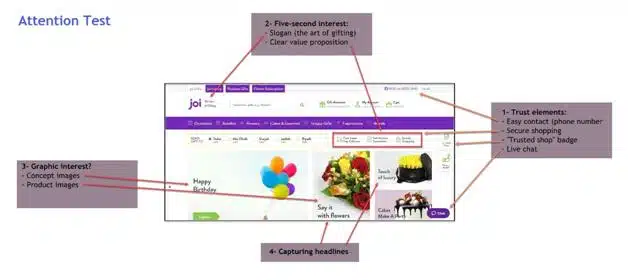
For unexpected events, to answer question 5, this website has a popup offering the visitor a 20% discount on their first order.
2. Interest stage: Information search
You captured the attention of your visitors and convinced them to give you a chance. Next, you need to capture their interest. This is where cognitive progression plays a role. You anticipate the needs of your visitors, their mindset, and the information they expect to see on your website. Accordingly, you present to them all data in a clear, concise, and persuasive matter.
The Interest Test
Answer these questions for each of your webpages:
- What is the most important information your visitor expects to see on a page?
- To answer this, you need to know what brought your visitors to the website. Go back to the keywords section in this article, figure out your top keywords, and test your page to see if it addresses visitors’ searches.
- Is the information presented on the page relevant to the visitor?
- Is your page visitor friendly?
- Is it easy for your visitor to find the information they need in a quick way?
- Do you present information in a clear way?
- Do you give your visitor a reason to stay on the website?
To gain and keep your visitors’ interest, you will need to present them with all the information they are seeking. On a product page, this would be:
- Product name
- Product features
- Product image
- Product price
- Product specifications and details (if applicable)
- Product reviews
Laptop Outlet is another B2C E-commerce website that sells laptops and accessories. Their product page speaks loud and clear: we have everything you need.
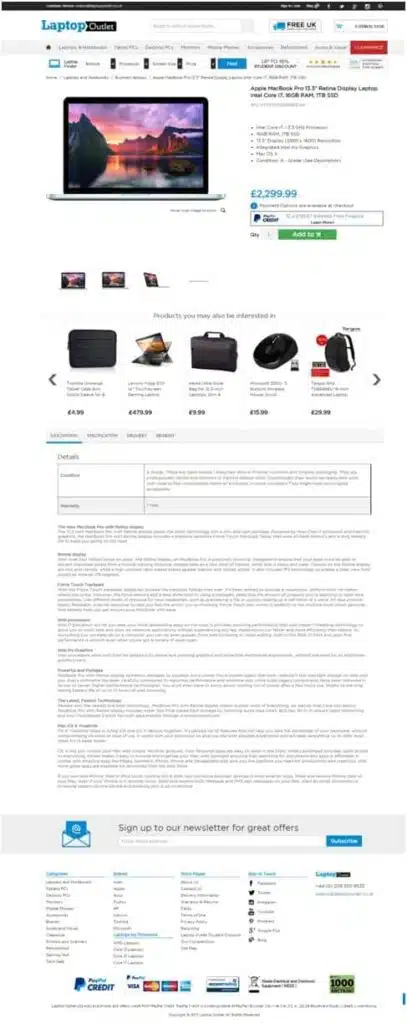
3. Desire Stage: Evaluation of Alternatives
Your visitors are now interested; next, you must convince them that they desire your product or service because it will satisfy their needs or solve one of their problems. Once you have that, you’ll find that even if lower prices are a strong motivator; giving your visitors what they want can still beat your competitors price.
The Desire Test
Let’s take Pug Shop Design as an example for this test. They are a B2B that provide design services to their visitors. Let’s answer these questions:
1. Are you able to convince visitors to stay on your website?
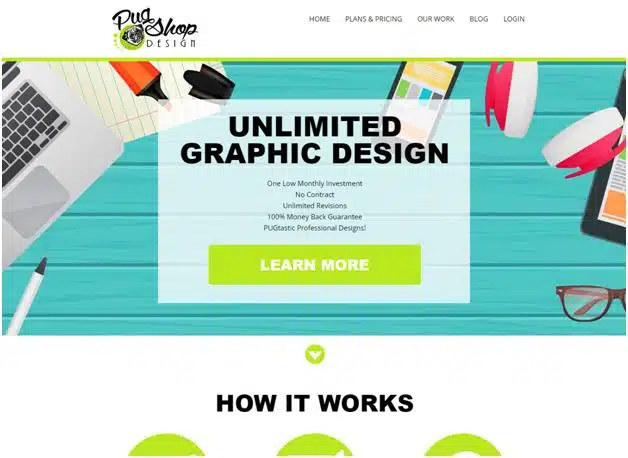
A clear value proposition is very likely to make me stay and scroll further down.
2. Are you able to persuade visitors to convert?
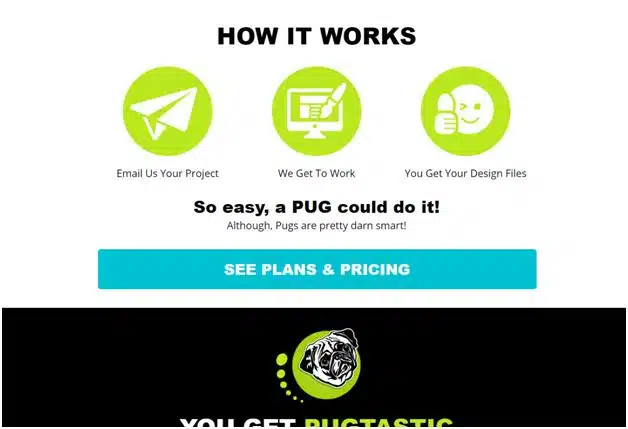
So,Pug Shop explained how easy it is to use their services. Now, they’re asking me to “see plans & pricing”, i.e. pushing me further down the funnel.
3. Do you use special offers to increase visitors’ desire?
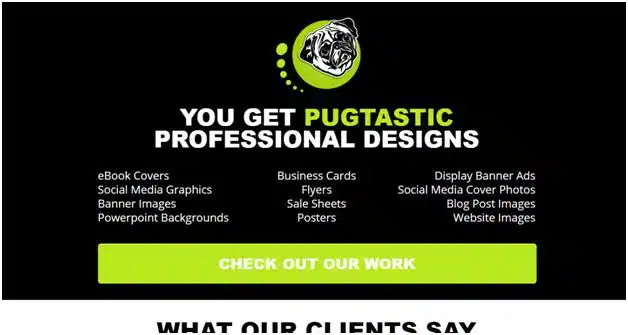
So,Pug Shop explained how easy it is to use their services. Now, they’re asking me to “see plans & pricing”, i.e. pushing me further down the funnel.
4. Do you communicate unique product benefits, or company benefits, effectively?
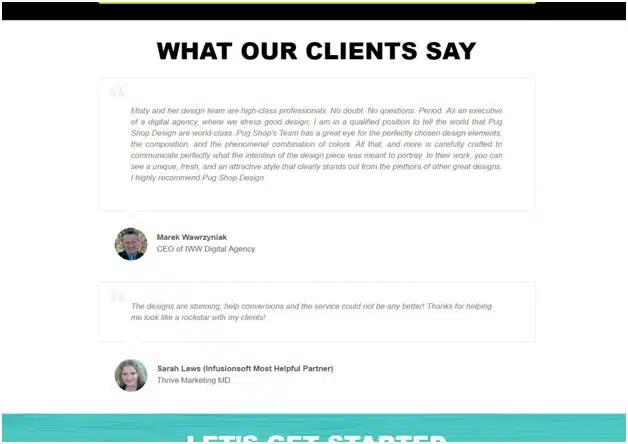
Pug Shop lets their customers communicate the benefits. Reviews and testimonials are excellent conversion boosters.
5. Are you able to use urgency and incentives to increase visitors’ desire?

No risk? Money back guarantee? I simply have nothing to lose at this point.
All queries above ads up to one last important question:
Do you utilize “must have” effect and other principles of psychology to increase visitor’s desire?Run this test on your website. If you’re not using incentives yet, learn more about giving your customers the biggest bang for their buck.
4. Action Stage
Every page on your website has a primary action you want visitors to take. Yes, we want visitors to convert (place an order, fill out a contact form, subscribe to our website), but getting to that macro conversion requires the visitor to go through a series of micro conversions (reading a piece of copy, clicking on a link, navigating to a page). Getting to the big “Yes” requires a series of small “yes’s.”
Think of the ways you get your visitors to take an action: are you gently guiding the visitor to take an action or are you pushing that visitor to take the action?What way works better for your visitors?
The Action Test
Answer these questions for each of yourwebpages:
- Do you have the most important action (primary action) defined for the page?
- Do you highlight the primaryaction on the page using copy and design? (check out our complete guide to effective CTA buttons)
- Is it obvious, logical, and desirable for every user to take the primary action?
- Are your primary actions laid out in a persuasive and clear process from one page to the next?
5. Post-Action Stage
What type of relationship do you have with your customers? To some degree, this will depend on the kindof product you sell. Some products are a one-in-a-life-time purchase; others have the customer coming to your website on a regular basis.It costs a lot less to retain a customer than to acquire one.Even for one-in-a-life-time products, you should think about the referrals customer can provide. So, how do you move from a single transaction into a long-term relation with the client?
The Satisfaction Test
Answer these questions for each of yourwebpages:
- Do you provide an easy and clear way for customer service on your website?
- Do you track customer satisfaction with your website?
- Do you track customer satisfaction with your products?
- Do you deploy customer exit survey on your website?
- Do you keep in touch with your customers via email, social media, and other forms?
A great way to contact and keep in touch with your customers/visitors is through polls. Visit our Polls 101 Guide to learn more, if you haven’t yet.
Conclusion
Visitors go through the buying stages on every journey of online purchases. The tests suggested in this article work for a B2C ecommerce website as much as they do for a B2B lead generation website.
By implementing these five tests, you will find which elements you can add or modify on your website to cover every aspect of the buying stages. To help you in determining these elements, we created thishandy checklist you can download and keep with you for easy access.



